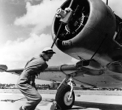HISTORY OF THE AT-6 TEXAN

The AT-6 is unquestionably the greatest training aircraft ever created. Originally built in 1935, it was used until the early 1990s to train hundreds of thousands of pilots from over 34 countries. The popularity of the AT-6 as a trainer earned it the nickname “Pilot Maker”. Anyone who has flown the aircraft will testify that it is more difficult to master the handling
techniques of the T-6 than most front line WWII fighters. It is this type of trainer that breeds champion level combat aviators.
The AT-6 evolved from the North American NA-16. North American Aviation designers and engineers Dutch Kindleberger, Lee Atwood and H.R.Raynor designed and built the first prototype, the NA-16, in nine weeks. The NA-16 was designed to compete against other aircraft as a basic combat trainer. Soon after, the NA-16 was changed to the BT-9 and several other designations before becoming the BC-1 or basic combat trainer. After a few more technological advances, the BC-1 evolved into the BC-2. The BC-2 is the airframe that formed the classic lines of the T-6/SNJ. Shortly after the BC-2, the AT-6 was born. The aircraft had several variations from the AT-6A through the T-6G and the Navy equivalents ranged from the SNJ-2 through the SNJ-7.
Even after the WWII, most allied forces had some form of the T-6 in their inventory and although the aircraft was mainly used as an advanced trainer, some used it as a front line fighter. In the Korean War the aircraft was used for close air support, firing smoke rockets to mark targets for incoming fighter-bombers. These T-6 ‘s were dubbed “Mosquitoes”.
The “AT” designation stood for “Advanced Trainer “ and was used for Advanced pilot training after the pilot cadets flight training in “Primary” aircraft. After completing flight training in the AT-6 they went on to either fighters such as the P-51 Mustang or Corsair or were assigned Transport Bomber aircraft such as the B-17 or B-25 . Later on in the late 1940‘s and early 1950‘s these aircraft became the “Primary” trainer and the designation changed simply to the T-6.
A total of over 14,000 AT-6’s were built from January of 1940 to August 1945 and more than 17000 variations built over the years referred to as NA-26, BC-1, NA-44, AT-6, SNJ, Texan, T-6, J-Bird, Harvard, Wirraway, Ceres, Mosquito and Pilot Maker .
Approximately 550 T-6s are in flight worthy condition today. With this kind of respect for the aircraft, it is no wonder why the T-6 is unquestionably the finest creation from North American Aviation.

North American At-6
T-6G SPECIFICATIONS
Wing Span: 42ft. 0.25in.
Length: 29ft. 6in.
Height: 11ft. 9in.
Max. Speed: 226 mph
Cruise speed: 150 mph
Range: 750 miles
Gross Weight: 5300 lbs
Empty Weight : 4150 lbs
Fuel Capacity: 140 gal.
+5.67 g -2.33 g
Service ceiling: 21,500 ft
ENGINE :
Pratt & Whitney 600 hp @ 2250 R1340 9 cylinder air-cooled radial
The R-1340 Wasp first ran in late 1925 and was quickly developed to 380 hp, rising to 425 hp by the third version. By the beginning of World War II, the R-1340 had a 600 hp take-off power rating at 2,250 rpm and a weight of 684 lb. One of the most successful aircraft engines ever designed, there were 34,966 R-1340 Wasps built between 1925 and 1960
PROPELLER :
Hamilton Standard Prop
Constant Speed
2 Blade Model 12D40
Diameter 9’ 1”


